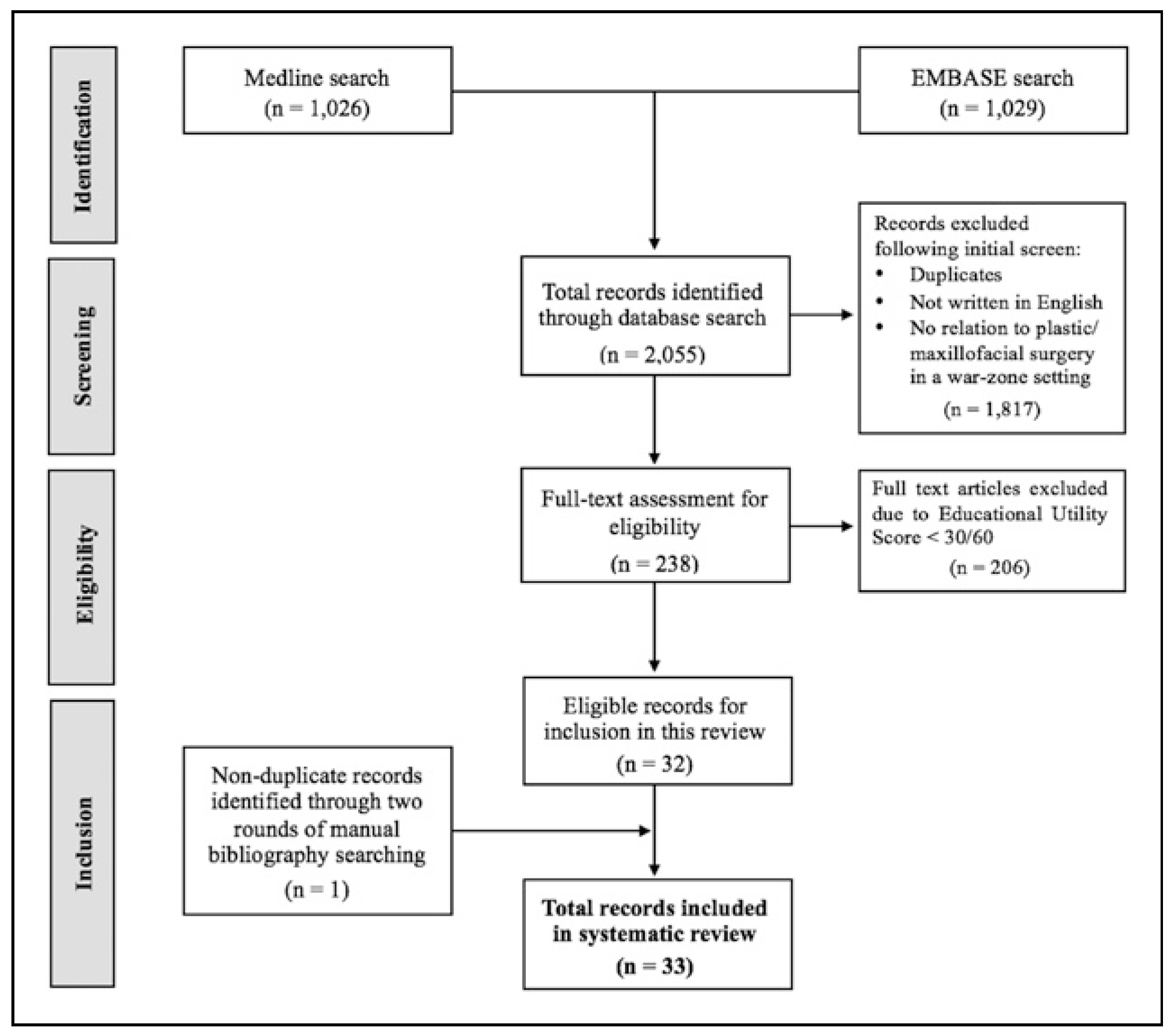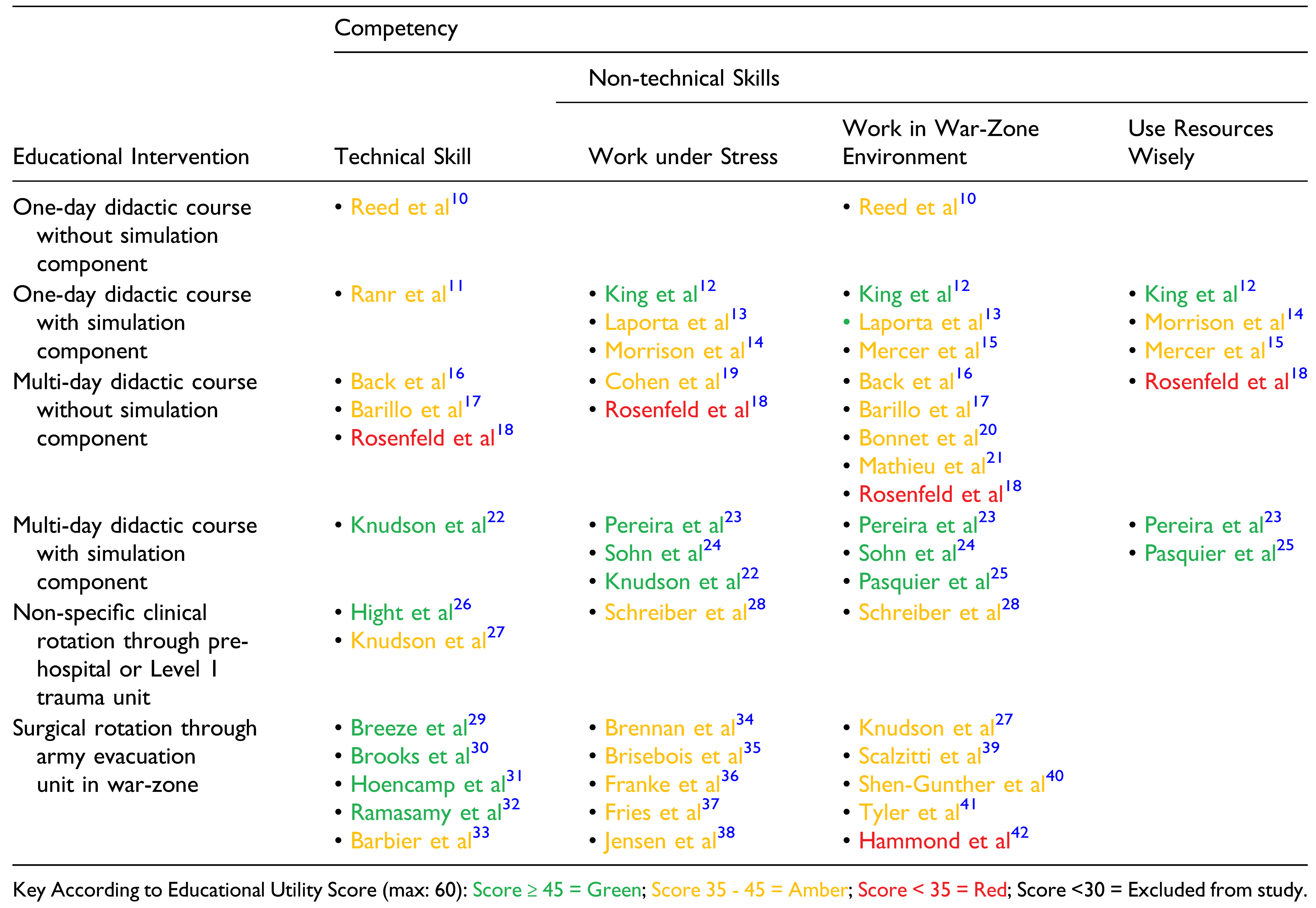Plastic and Maxillofacial Training for War-Zones—A Systematic Review
Abstract
:Introduction
Methodology
Aims
Review Technique
Search Strategy
Inclusion and Exclusion of Literature
Evaluation of Included Literature
Results
Discussion
Injuries and Surgical Practice in the Combat Setting
Current Preparation of Surgeons to Manage Mass Trauma in Austere Environments
Training Limitations and Scope for Improvement
Conclusion
Supplementary Materials
Funding
Conflicts of Interest
References
- Long, F.X. Les blesses de la face Durant la Grande Guerre: Les origins de la chirugie maxillofaciale. Hist. Sci. Med. 2002, 36, 175–184. [Google Scholar] [PubMed]
- Fang, F.; Chung, K.C. An evolutionary perspective on the history of flap reconstruction in the upper extremity. Hand Clin. 2014, 30, 109–122. [Google Scholar] [PubMed]
- Watch, H.R. Syria-Events of. 2017. Available online: www.hrw.org/worldreport/ 2018/country-chapters/syria.2018.
- Afghanistan. UNAMi. Afghanistan special report: Increasing harm from the deliberate and indiscriminate use of improvised explosive devices. 2018. [Google Scholar]
- Beirut Explosion the Guardian2020. Available online: https://www.theguardian. com/world/live/2020/aug/04/beirut-explosion-huge-blast-portlebanon- capital.
- Cardi, M.; Ibrahim, K.; Alizai, S.W.; et al. Injury patterns and causes of death in 953 patients with penetrating abdominal war wounds in a civilian independent non-governmental organization hospital in Lashkargah, Afghanistan. World J. Emerg. Surg. 2019, 14, 51. [Google Scholar]
- Moher, D.; Liberati, A.; Tetzlaff, J.; Altman, D.G. Preferred reporting items for systematic reviews and meta-analyses: The PRISMA statement. PLoS Med. 2009, 6, e1000097. [Google Scholar]
- (BETs) BET. BestBETs’ Educational intervention checklist.
- HJaG, S. Handbook for Systematic Reviews of Interventions. Version 5.1.0 (updated March 2011). Chapter 8: Assessing Risk of Bias. Available online: https://handbook-5-1.cochrane.org/chapter_8/_ assessing_risk_of_bias_in_included_studies.htm.
- Reed, B.E.; Hale, R.G. Training Australian military health care personnel in the primary care of maxillofacial wounds from improvised explosive devices. J. R. Army Med. Corps 2010, 156, 121–124. [Google Scholar]
- Ranr, L.; Rehak, A.; Fanzea, M.; et al. (Eds.) Simulation Training for ADF Surgical and Intensive Care Teams: A Pilot Study2009.
- King, D.R.; Patel, M.B.; Feinstein, A.J.; Earle, S.A.; Topp, R.F.; Proctor, K.G. Simulation training for a mass casualty incident: Two-year experience at the army trauma training center. J. Trauma. 2006, 61, 943–948. [Google Scholar]
- Laporta, A.J.; Hoang, T.; Moloff, A.; et al. From trauma in austere environments to combat or medical school: How blended hyper-realism in the real and virtual worlds can better prepare surgeons. Stud. Health Technol. Inform. 2014, 196, 233–237. [Google Scholar]
- Morrison, J.J.; Forbes, K.; Woolrich-Burt, L.; Russell, R.; Mahoney, P.F. Medium-fidelity medical simulators: Use in a pre-hospital, operational, military environment. J. R. Army Med. Corps 2006, 152, 132–135. [Google Scholar]
- Mercer, S.J.; Howell, M.; Simpson, R. Simulation training for the frontline-realistic preparation for role 1 doctors. J. R. Army Med. Corps 2010, 156, 87–89. [Google Scholar]
- Back, D.A.; Waldmann, K.; Hauer, T.; et al. Concept and evaluation of the German War surgery course-Einsatzchirurgie-Kurs der Bundeswehr. J. R. Army Med. Corps 2017, 163, 206–210. [Google Scholar]
- Barillo, D.J.; Cancio, L.C.; Hutton, B.G.; Mittelsteadt, P.J.; Gueller, G.E.; Holcomb, J.B. Combat burn life support: A military burn-education program. J. Burn. Care Rehabil. 2005, 26, 162–165. [Google Scholar] [CrossRef] [PubMed]
- Colonel, L.; Rosenfeld, J.V. (Eds.) Training the Military Surgeon: Definitive Surgical Trauma Course (DSTC) and the Development of a Military Module2002.
- Cohen, D.; Sevdalis, N.; Taylor, D.; et al. Emergency preparedness in the 21st century: Training and preparation modules in virtual environments. Resuscitation 2013, 84, 78–84. [Google Scholar]
- Bonnet, S.; Gonzalez, F.; Mathieu, L.; et al. The French advanced course for deployment surgery (ACDS) called cours avance de Chirurgie en mission extérieure (CACHIRMEX): History of its development and future prospects. J. R. Army Med. Corps 2016, 162, 343–347. [Google Scholar]
- Mathieu, L.; Joly, B.; Bonnet, S.; et al. Modern teaching of military surgery: Why and how to prepare the orthopaedic surgeons before deployment? The French experience. Int. Orthop. 2015, 39, 1887–1893. [Google Scholar] [PubMed]
- Knudson, M.M.; Khaw, L.; Bullard, M.K.; Dicker, R.; Cohen, M.J.; Staudenmayer, K.; et al. Trauma training in simulation: Translating skills from SIM time to real time. J. Trauma. 2008, 64, 255–264, discussion 63–4.. [Google Scholar] [PubMed]
- Pereira, B.M.; Ryan, M.L.; Ogilvie, M.P.; et al. Predeployment mass casualty and clinical trauma training for US Army forward surgical teams. J. Craniofac. Surg. 2010, 21, 982–986. [Google Scholar]
- Sohn, V.Y.; Miller, J.P.; Koeller, C.A.; et al. From the combat medic to the forward surgical team: The Madigan model for improving trauma readiness of brigade combat teams fighting the global war on terror. J. Surg. Res. 2007, 138, 25–31. [Google Scholar]
- Pasquier, P.; Mérat, S.; Malgras, B.; et al. A Serious game for massive training and assessment of french soldiers involved in forward combat casualty care (3D-SC1): Development and deployment. JMIR Serious Games 2016, 4, e5. Available online: http://europepmc.org/abstract/MED/27194369.
- Hight, R.A.; Salcedo, E.S.; Martin, S.P.; Cocanour, C.S.; Utter, G.; Galante, J.M. Level I academic trauma center integration as a model for sustaining combat surgical skills: The right surgeon in the right place for the right time. J. Trauma. Acute Care Surg. 2015, 78, 1176–1181. [Google Scholar]
- Knudson, M.M.; Evans, T.W.; Fang, R.; et al. A concluding after-action report of the senior visiting surgeon program with the United States Military at Landstuhl regional medical center, Germany. J. Trauma. Acute Care Surg. 2014, 76, 878–883. [Google Scholar]
- Schreiber, M.A.; Holcomb, J.B.; Conaway, C.W.; Campbell, K.D.; Wall, M.; Mattox, K.L. Military trauma training performed in a civilian trauma center. J. Surg. Res. 2002, 104, 8–14. [Google Scholar] [CrossRef] [PubMed]
- Brezec, J.; Monaghan, A.M.; Williams, M.D.; Clark, R.N.; Gibbons, A.J. Five months of surgery in the multinational field hospital in Afghanistan with an emphasis on oral and maxillofacial injuries. J. R. Army Med. Corps 2010, 156, 125–128. [Google Scholar] [CrossRef]
- Brooks, A.J.; Ramasamy, A.; Hinsley, D.; Midwinter, M. Military general surgical training opportunities on operations in Afghanistan. Ann. R. Coll. Surg. Engl. 2009, 91, 417–419. [Google Scholar] [CrossRef]
- Hoencamp, R.; Tan, E.C.; Idenburg, F.; et al. Challenges in the training of military surgeons: Experiences from Dutch combat operations in southern Afghanistan. Eur. J. Trauma. Emerg. Surg. 2014, 40, 421–428. [Google Scholar] [CrossRef]
- Ramasamy, A.; Hinsley, D.E.; Edwards, D.S.; Stewart, M.P.; Midwinter, M.; Parker, P.J. Skill sets and competencies for the modern military surgeon: Lessons from UK military operations in Southern Afghanistan. Injury 2010, 41, 453–459. [Google Scholar] [CrossRef]
- Barbier, O.; Racle, M. Has current french training for military orthopedic surgeons deployed in external operations been appropriately adapted? Mil. Med. 2018, 183, e411–e415. [Google Scholar] [CrossRef] [PubMed]
- Brennan, J. Head and neck trauma in Iraq and Afghanistan: different war, different surgery, lessons learned. Laryngoscope 2013, 123, 2411–2417. [Google Scholar] [CrossRef]
- Brisebois, R.J.; Tien, H.C. Surgical experience at the Canadian-led role 3 multinational medical unit in Kandahar, Afghanistan. J. Trauma. 2011, 71 (Suppl. 1), S397–S400. [Google Scholar] [CrossRef] [PubMed]
- Franke, A.; Hentsch, S.; Bieler, D.; et al. Management of soft-tissue and bone defects in a local population: Plastic and reconstructive surgery in a deployed military setting. Mil. Med. 2017, 182, e2010–e2020. [Google Scholar] [CrossRef]
- Fries, C.A.; Rickard, R.F. Surgical training in camp bastion, Afghanistan. J. R. Nav. Med. Serv. 2012, 98, 23–27. [Google Scholar] [CrossRef]
- Jensen, S.; Tadlock, M.D.; Douglas, T.; Provencher, M.; Ignacio, R.C., Jr. Integration of surgical residency training with US military humanitarian missions. J. Surg. Educ. 2015, 72, 898–903. [Google Scholar] [CrossRef]
- Scalzitti, N.; Brennan, J.; Bothwell, N.; et al. Military otolar-yngology resident case numbers and board passing rates during the Afghanistan and Iraq wars. Otolaryngol. Head. Neck Surg. 2014, 150, 787–791. [Google Scholar] [CrossRef] [PubMed]
- Shen-Gunther, J.; Ellison, R.; Kuhens, C.; Roach, C.J.; Jarrard, S. Operation Enduring Freedom: trends in combat casualty care by forward surgical teams deployed to Afghanistan. Mil. Med. 2011, 176, 67–78. [Google Scholar] [PubMed]
- Tyler, J.A.; Clive, K.S.; White, C.E.; Beckley, A.C.; Blackbourne, L.H. Current US military operations and implications for military surgical training. J. Am. Coll. Surg. 2010, 211, 658–662. [Google Scholar] [CrossRef]
- Hammond, D.; Brezec, J.; Evriviades, D. The reconstructive trauma surgery interface fellowship and its applicability to military and civilian trainees. J. R. Army Med. Corps 2018, 164, 360–361. [Google Scholar] [PubMed]
- Trudeau, M.O.; Baron, E.; Herard, P.; et al. Surgical care of pediatric patients in the humanitarian setting: The médecins sans frontières experience, 2012-2013. JAMA Surg 2015, 150, 1080–1085. [Google Scholar]
- Brezec, J.; Combes, J.G.; DuBose, J.; Powers, D.B. How are we currently training and maintaining clinical readiness of US and UK military surgeons responsible for managing head, face and neck wounds on deployment? J. R. Army Med. Corps 2018, 164, 183–185. [Google Scholar]
- Giblin, A.; Wright, T.; Henley, M.; Sandhu, D.; Evriviades, D. Reconstructive trauma surgery interface fellowship. BMJ 2012, 345, e7258. [Google Scholar]
- Choufani, C.; Barbier, O.; Mayet, A.; Rigal, S.; Mathieu, L. Preparedness evaluation of french military orthopedic surgeons before deployment. Mil. Med. 2019, 184, e206–e212. [Google Scholar] [CrossRef]
- Haverkamp, F.J.C.; Voen, H.; Hoencamp, R.; et al. Prepared for mission? A survey of medical personnel training needs within the international committee of the red cross. World J. Surg. 2018, 42, 3493–3500. [Google Scholar]
- Crank, D.R.; Hetz, S.P.; Azarow, K.S. Are Army-trained surgeons satisfied with their residencies? Curr. Surg. 2005, 62, 199–203. [Google Scholar] [CrossRef] [PubMed]
- Dubose, J.; Rodriguez, C.; Martin, M.; et al. Preparing the surgeon for war: Present practices of US, UK, and Canadian militaries and future directions for the US military. J. Trauma. Acute Care Surg. Suppl. 2012, 73, S423–S430. [Google Scholar]
- England RCoS. Surgical training for austere environments (STAE). Available online: https://www.rcseng.ac.uk/education-andexams/courses/ search/surgical-training-for-austere-environments-stae/.

 |
 |
  |
© 2022 by the author. Multimed Inc.
Share and Cite
Borg, T.-M.; Cavale, N.; Abu-Sittah, G.; Ghanem, A. Plastic and Maxillofacial Training for War-Zones—A Systematic Review. Craniomaxillofac. Trauma Reconstr. 2023, 16, 154-162. https://doi.org/10.1177/19433875221083416
Borg T-M, Cavale N, Abu-Sittah G, Ghanem A. Plastic and Maxillofacial Training for War-Zones—A Systematic Review. Craniomaxillofacial Trauma & Reconstruction. 2023; 16(2):154-162. https://doi.org/10.1177/19433875221083416
Chicago/Turabian StyleBorg, Tiffanie-Marie, Naveen Cavale, Ghassan Abu-Sittah, and Ali Ghanem. 2023. "Plastic and Maxillofacial Training for War-Zones—A Systematic Review" Craniomaxillofacial Trauma & Reconstruction 16, no. 2: 154-162. https://doi.org/10.1177/19433875221083416
APA StyleBorg, T.-M., Cavale, N., Abu-Sittah, G., & Ghanem, A. (2023). Plastic and Maxillofacial Training for War-Zones—A Systematic Review. Craniomaxillofacial Trauma & Reconstruction, 16(2), 154-162. https://doi.org/10.1177/19433875221083416




